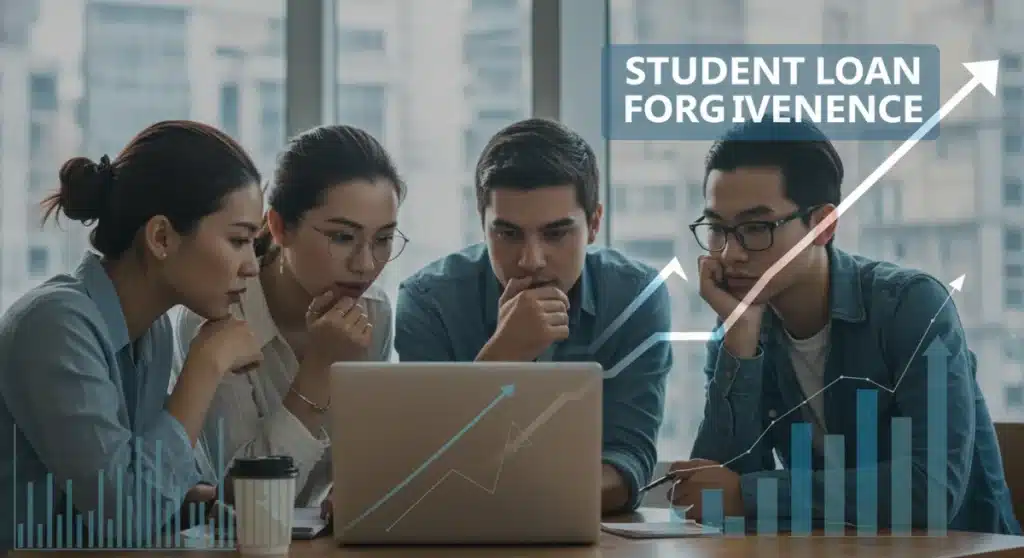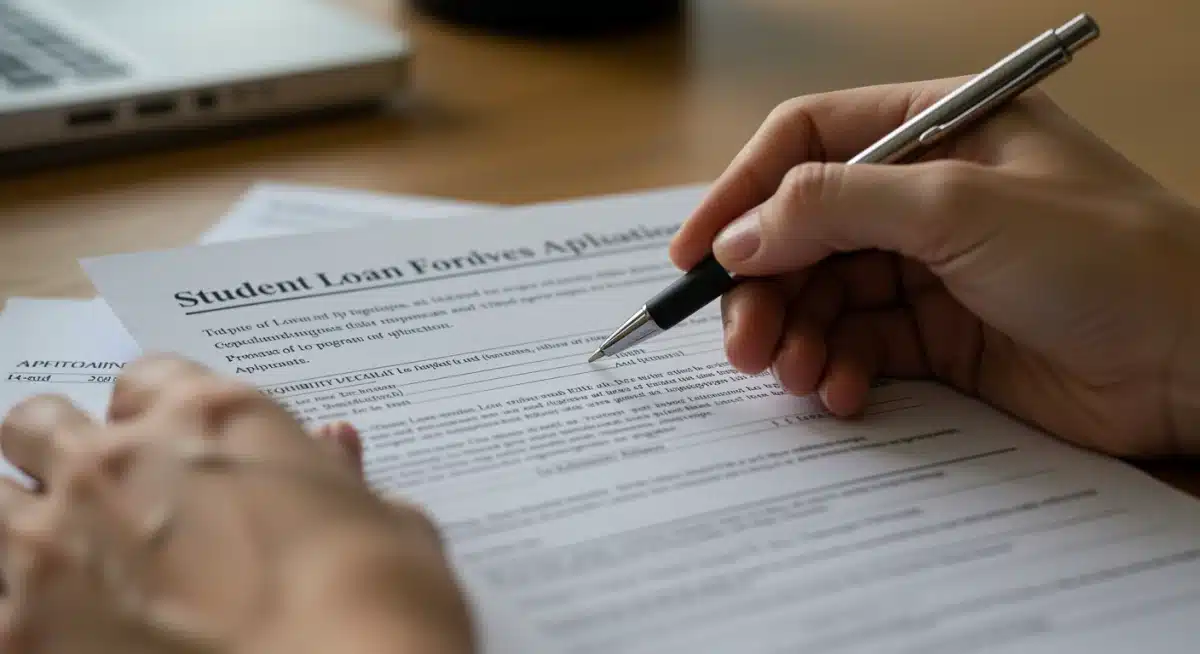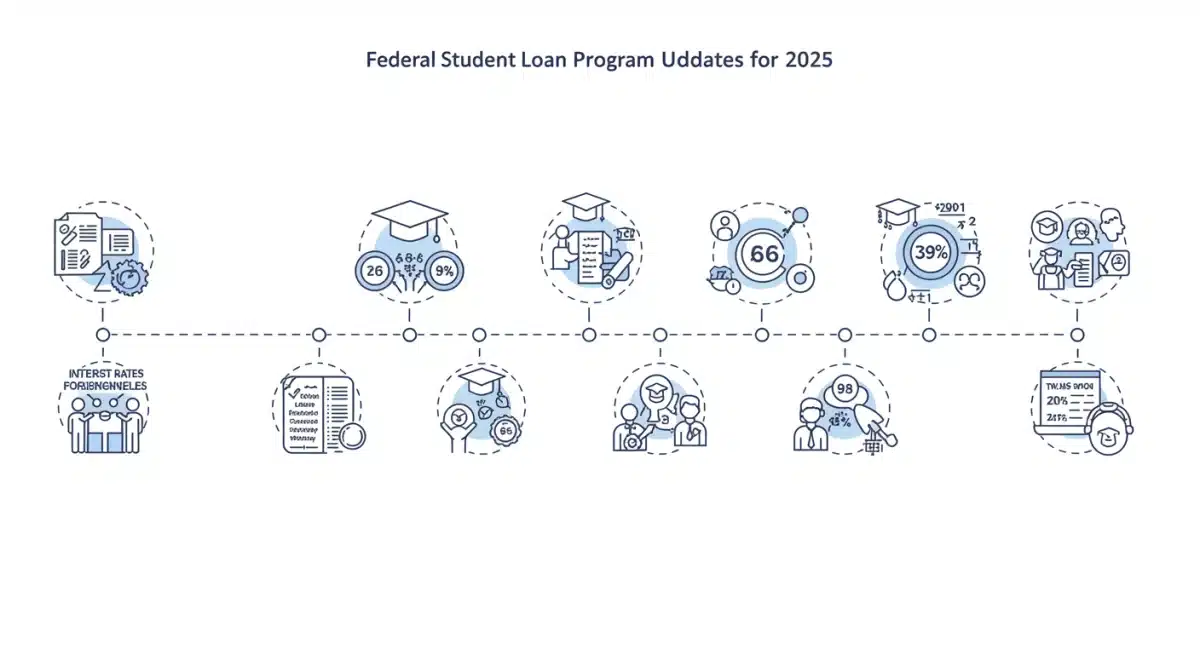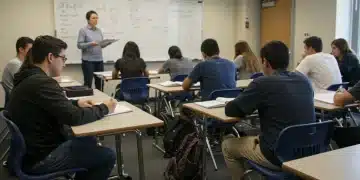Student Loan Forgiveness 2025: Federal Programs & Eligibility Updates

Latest developments on student loan forgiveness in 2025 include critical federal program updates and revised eligibility requirements, impacting millions of borrowers across the United States with significant financial implications.
Student loan forgiveness in 2025 is a topic of paramount importance for millions of Americans navigating their financial futures. As new federal programs take shape and existing policies evolve, understanding the latest eligibility requirements and the potential financial impact is crucial for borrowers seeking relief. This article delves into the most recent updates, offering a clear and immediate perspective on what you need to know now.
Understanding the Current Landscape of Federal Student Loan Forgiveness
The landscape of student loan forgiveness is continuously shifting, influenced by legislative actions, executive orders, and administrative adjustments. For 2025, several key federal programs are undergoing significant changes or are being introduced, aiming to address the persistent issue of student debt. These programs often target specific borrower groups or circumstances, making it essential to identify which ones might apply to your situation.
Recent announcements from the Department of Education indicate a renewed focus on streamlining application processes and expanding access to existing forgiveness pathways. This includes initiatives designed to reach borrowers who previously faced bureaucratic hurdles or were unaware of their eligibility. The emphasis is on providing clearer guidance and more robust support systems to ensure that eligible individuals can successfully apply for relief.
Key federal programs in focus for 2025
- Public Service Loan Forgiveness (PSLF): This program continues to be a cornerstone of federal forgiveness initiatives, offering debt cancellation to those working in public service careers after 120 qualifying payments.
- Income-Driven Repayment (IDR) Plan Adjustments: Changes to IDR plans, including the new SAVE plan, are set to offer more affordable monthly payments and shorter paths to forgiveness for many borrowers.
- Targeted Forgiveness Initiatives: The administration is exploring additional targeted forgiveness programs for specific groups, such as borrowers with disabilities, those who attended predatory institutions, or individuals with long-standing debt burdens.
The overarching goal of these federal programs is to alleviate the financial strain on borrowers, stimulate economic growth, and ensure that higher education remains an accessible and worthwhile investment. Staying informed about these developments is the first step toward potentially benefiting from these critical opportunities.
Eligibility Requirements: Navigating the Nuances of Forgiveness Programs
Eligibility for student loan forgiveness in 2025 is not a one-size-fits-all scenario. Each federal program comes with its own set of criteria, which can range from employment type and income levels to repayment history and loan types. Understanding these specific requirements is crucial to determining whether you qualify for any relief. Misinterpreting eligibility rules can lead to missed opportunities or delays in processing applications.
For example, the Public Service Loan Forgiveness (PSLF) program requires borrowers to be employed full-time by a qualifying non-profit organization or government agency. They must also make 120 qualifying monthly payments under a specific repayment plan. Any deviation from these requirements, such as working for a for-profit entity or making payments under a non-qualifying plan, can jeopardize eligibility. The Department of Education has been working to clarify these rules and provide tools for borrowers to track their progress more effectively.
Understanding loan types and their impact on eligibility
- Direct Loans: Most federal forgiveness programs primarily target Direct Loans. If you have Federal Family Education Loans (FFEL) or Perkins Loans, you may need to consolidate them into a Direct Consolidation Loan to become eligible.
- Private Loans: It is important to note that federal forgiveness programs do not apply to private student loans. Borrowers with private loans must explore other relief options, such as refinancing or deferment through their private lenders.
Furthermore, income thresholds play a significant role in many income-driven repayment (IDR) plans, which can lead to forgiveness after a certain period. The new SAVE plan, for instance, adjusts how discretionary income is calculated, potentially lowering monthly payments and accelerating the path to forgiveness for many low- and middle-income borrowers. Regularly checking your loan status, understanding your repayment history, and confirming your employment details are vital steps in assessing your eligibility for student loan forgiveness in 2025.
Recent Updates and Their Financial Impact on Borrowers
The past year has seen a flurry of activity regarding federal student loan policies, with several significant updates directly impacting borrowers in 2025. These changes are not merely administrative; they carry substantial financial implications, potentially saving borrowers thousands of dollars and significantly altering their repayment timelines. Keeping abreast of these developments is key to maximizing your financial well-being.
One of the most impactful recent updates is the ongoing implementation and expansion of the SAVE (Saving on a Valuable Education) plan. This new income-driven repayment plan offers more generous terms than previous IDR options, such as eliminating 100% of remaining interest for borrowers who make their monthly payments, preventing loan balances from growing. It also shortens the repayment period for some borrowers, allowing for forgiveness after as few as 10 years of payments, depending on the original loan amount.

Key financial impacts of recent changes
- Reduced monthly payments: Many borrowers on the SAVE plan will see their monthly payments significantly lowered, freeing up disposable income.
- Faster path to forgiveness: Shorter repayment periods under certain IDR plans mean borrowers can achieve forgiveness sooner, reducing the total interest paid over the life of the loan.
- Interest accrual benefits: Forgiveness of unpaid interest under the SAVE plan prevents loan balances from ballooning, a common frustration for borrowers on traditional IDR plans.
- Expanded PSLF eligibility: Efforts to simplify PSLF and broaden what counts as qualifying employment or payments mean more public servants can access forgiveness.
These financial adjustments represent a significant shift in how federal student loans are managed, offering a lifeline to many borrowers who have struggled with repayment. The goal is to make student debt more manageable and the path to forgiveness more attainable, directly influencing the financial stability of families across the nation.
The Role of the Department of Education and Federal Policy
The U.S. Department of Education plays a pivotal role in shaping and implementing all federal student loan forgiveness programs. Its directives, guidelines, and administrative actions directly determine how programs like PSLF and IDR plans function, as well as how new initiatives are rolled out. Understanding the Department’s current priorities and policy direction is crucial for anyone following student loan forgiveness in 2025.
Currently, the Department is focused on several key areas. First, it aims to simplify the application and recertification processes for existing programs, reducing the administrative burden on borrowers. This includes leveraging data to automatically enroll eligible borrowers in certain benefits or credit them with qualifying payments. Second, there’s a strong push for greater transparency and communication, ensuring borrowers are fully aware of their options and any changes to policy. This involves clearer website information, proactive outreach campaigns, and improved customer service for federal loan servicers.
How federal policy influences forgiveness outcomes
- Legislative stability: While some changes come through executive action, long-term stability often depends on legislative support, which can influence the longevity and scope of forgiveness programs.
- Administrative efficiency: The Department’s ability to efficiently process applications and provide accurate information directly impacts how quickly borrowers can receive forgiveness.
- Data sharing and automation: Increased data sharing between federal agencies can streamline eligibility verification, reducing the need for borrowers to submit extensive documentation.
The ongoing efforts by the Department of Education are central to the effectiveness of student loan forgiveness initiatives. Their commitment to improving borrower experience and ensuring equitable access to relief will largely determine the success and reach of these programs in the coming years.
How to Prepare for Student Loan Forgiveness in 2025
Preparing for potential student loan forgiveness in 2025 requires proactive steps and careful attention to detail. While the federal landscape continues to evolve, there are concrete actions borrowers can take now to ensure they are well-positioned to benefit from any available programs. Waiting until the last minute can lead to missed deadlines or incomplete applications, jeopardizing your chances for relief.
First, it is essential to consolidate any older federal loans, such as FFEL or Perkins Loans, into a Direct Consolidation Loan. This step is often a prerequisite for eligibility in many federal forgiveness programs, including PSLF and most IDR plans. The consolidation process can take several weeks, so it is advisable to start early. Second, make sure your contact information with your loan servicer is up-to-date. This ensures you receive important communications about program changes, application deadlines, and status updates.

Essential preparation steps for borrowers
- Review your loan details: Understand your loan types, current balances, and repayment history by checking your account on StudentAid.gov.
- Research eligibility criteria: Familiarize yourself with the specific requirements for PSLF, IDR plans (especially SAVE), and any targeted forgiveness initiatives that might apply to you.
- Track qualifying payments: If you are pursuing PSLF, ensure you are tracking your 120 qualifying payments and submitting employment certification forms annually.
- Stay informed: Regularly check official sources like StudentAid.gov and reputable news outlets for the latest updates on federal student loan policies.
- Seek professional advice: Consider consulting with a financial advisor or a non-profit student loan counselor if you have complex loan situations or need personalized guidance.
By taking these preparatory steps, borrowers can significantly increase their likelihood of successfully navigating the student loan forgiveness landscape in 2025 and securing the relief they are entitled to.
Potential Challenges and Future Outlook for Forgiveness Programs
Despite the positive momentum surrounding student loan forgiveness in 2025, several challenges and uncertainties remain. The political landscape, budgetary constraints, and potential legal challenges could all impact the scope and longevity of current and future forgiveness programs. Borrowers should remain cautiously optimistic and stay informed about any developments that could alter their repayment strategies.
One significant challenge is the ongoing debate in Congress regarding the funding and long-term sustainability of these programs. While the current administration has made student loan relief a priority, future administrations or shifts in congressional power could lead to policy changes. Additionally, legal challenges to broad forgiveness initiatives have emerged in the past, and similar hurdles could arise for new programs, potentially delaying or altering their implementation.
Factors influencing the future outlook
- Political climate: Changes in presidential administrations or congressional majorities can lead to significant shifts in student loan policy.
- Economic conditions: The broader economic environment, including inflation and employment rates, can influence the urgency and political will behind student loan relief efforts.
- Budgetary considerations: The cost of large-scale forgiveness programs can be a point of contention, impacting their long-term viability and the extent of relief offered.
- Legal precedents: Court rulings on past forgiveness attempts could set precedents for future challenges, affecting how new programs are designed and implemented.
Despite these potential headwinds, the general trend indicates a continued effort to address student loan debt. Borrowers should focus on understanding the programs currently available and prepare for potential adjustments, ensuring they are adaptable to future changes in policy. The outlook for student loan forgiveness in 2025 is dynamic, requiring ongoing vigilance and informed decision-making.
Key Point |
Brief Description > |
|---|---|
New Federal Programs |
Focus on PSLF, expanded IDR plans like SAVE, and targeted relief initiatives for specific borrower groups. |
Eligibility Updates |
Criteria vary by program, often requiring specific loan types (Direct Loans), employment, and repayment history. |
Financial Impact |
Potential for reduced monthly payments, faster forgiveness, and interest accrual benefits, significantly easing borrower burden. |
Preparation Steps |
Consolidate loans, update contact info, track payments, and stay informed through official Department of Education channels. |
Frequently Asked Questions About Student Loan Forgiveness in 2025
The main federal programs include Public Service Loan Forgiveness (PSLF), various Income-Driven Repayment (IDR) plans like the new SAVE plan, and targeted forgiveness initiatives for specific borrower circumstances. These programs aim to reduce or eliminate student debt for eligible individuals.
The SAVE plan offers lower monthly payments by adjusting discretionary income calculations and prevents loan balances from growing due to unpaid interest. It also provides a faster path to forgiveness for some borrowers, potentially after as little as 10 years of payments.
No, federal student loan forgiveness programs, including PSLF and IDR plans, only apply to federal student loans. Private student loans are not eligible and require borrowers to explore other relief options directly with their private lenders.
You should consolidate older federal loans if necessary, update your contact information with your loan servicer, and regularly check your loan details on StudentAid.gov. Staying informed about program changes and eligibility requirements is also crucial.
Potential challenges include shifts in the political landscape, budgetary considerations, and possible legal challenges to new or existing programs. Borrowers should remain vigilant and adaptable to ensure they can adjust their strategies as policies evolve.
Outlook and Implications
The evolving landscape of student loan forgiveness in 2025 underscores a continued commitment to addressing the nation’s student debt crisis. While programs like PSLF and the SAVE plan offer substantial relief, borrowers must remain proactive in understanding eligibility and preparing for potential policy shifts. The coming year will likely bring further clarifications and adjustments, emphasizing the need for ongoing vigilance and informed decision-making to harness these critical financial opportunities.





